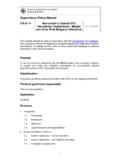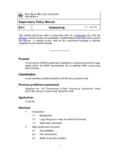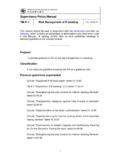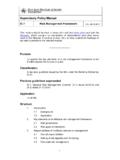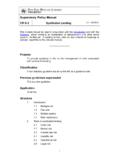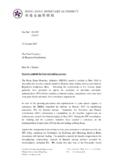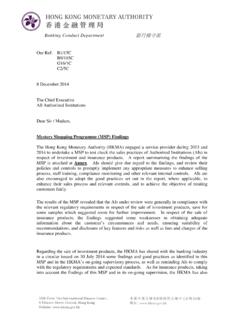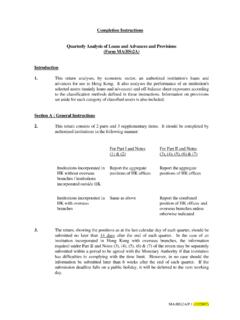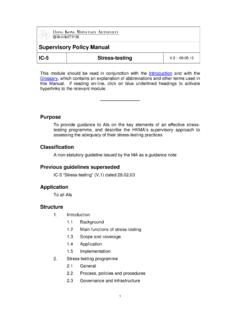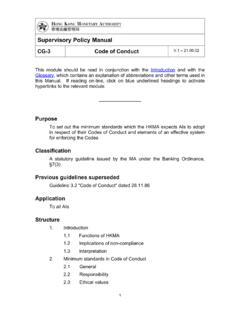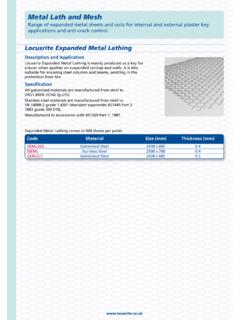Transcription of Supervisory Policy Manual - Hong Kong Monetary …
1 Supervisory Policy Manual CG-7 Code of Conduct for Benchmark Submitters 1 This module should be read in conjunction with the Introduction and with the Glossary, which contains an explanation of abbreviations and other terms used in this Manual . If reading on-line, click on blue underlined headings to activate hyperlinks to the relevant module. Purpose To set out the minimum standards on systems of control which the Hong Kong Monetary Authority (HKMA) expects AIs, which are submitting rates for the benchmark fixing process, to put in place. To provide guidance on what and how to use relevant data in arriving at the data they submit for the fixing process. Classification A statutory guideline issued by the Monetary Authority (MA) under the Banking Ordinance, 7(3).
2 Previous guidelines superseded CG-7 Code of Conduct for Benchmark Submitters ( ) dated Application To all AIs which are submitting rates for benchmark fixings. Benchmarks in this module include HKAB s HKD Interest Settlement Rate (more commonly known as the Hong Kong Interbank Offered Rate or HKD HIBOR), the TMA s CNH Hong Kong Interbank Offered Rate and fixings of other types which may be specified by the HKMA in the future. Structure 1. Introduction Functions of HKMA Responsibility of managers Implications of non-compliance Interpretation Supervisory Policy Manual CG-7 Code of Conduct for Benchmark Submitters 22. Basic principles in Code Organisational and governance arrangements Conflicts of interest Retention of records Independent reviews Handling complaints and whistleblower reports Timely submissions Annex A Code of Conduct for Reference Banks for HKAB s Interest Settlement Rate Annex B Code of Conduct for Reference Banks for TMA s CNH Hong Kong Interbank Offered Rate Supervisory Policy Manual CG-7 Code of Conduct for Benchmark Submitters 3 1.
3 Introduction Functions of HKMA The HKMA s primary function under the Banking Ordinance is to promote the general stability and effective working of the Hong Kong banking system. Good and ethical banking practices are essential for safeguarding depositors interests, maintaining the stability of the banking system and preserving Hong Kong s reputation as an international financial centre. Under 7 of the Banking Ordinance, the MA has the functions, inter alia, to: take reasonable steps to ensure that AIs operate in a responsible, honest and business-like manner; promote and encourage proper standards of conduct and sound and prudent business practices among AIs; and suppress, and aid in suppressing, illegal, dishonourable and improper practices in relation to the business conducted by AIs.
4 As financial market benchmarks are relied upon in the valuation and settlement of financial contracts and manipulation of major financial market benchmarks could have important implications for the economy at large, the HKMA believes that it is consistent with these functions to require AIs involved in benchmark setting activities to ensure proper oversight over such activities and put in place effective systems of control. Responsibility of managers In the Fourteenth Schedule of the Banking Ordinance, the business or affairs specified for the purposes of the Supervisory Policy Manual CG-7 Code of Conduct for Benchmark Submitters 4definition of a manager1 are, amongst others: the carrying on of retail banking, private banking, corporate banking, international banking, institutional banking, treasury or any other business which is material to the AI; the maintenance of systems of control of an AI, including those systems intended to manage the risks of the AI; and the function of ensuring that an AI complies with laws, regulations or guidelines that are applicable to it ( the compliance function).
5 As the benchmark is referenced in interbank market transactions, and used in the valuation and settlement of financial contracts of bank s treasury business, the HKMA believes AIs have the duty to ensure the integrity and robustness of the benchmark setting process. The HKMA therefore holds the managers for treasury business, risk management, and compliance accountable to the robustness of their AI s benchmark submissions. Among them, the manager of treasury business shall assume primary responsibility for ensuring the integrity and credibility of the benchmark submission process. Implications of non-compliance The minimum authorization criterion under para. 10 of 1 Under 2 of the Banking Ordinance, a manager of a locally incorporated AI means any individual (other than a director or chief executive, including an alternate chief executive) appointed by the AI, or by a person acting for or on behalf of or by arrangement with the AI, to be principally responsible, either alone or with others, for the conduct of any one or more of its affairs or business specified in the Fourteenth Schedule to the Ordinance.
6 For an overseas incorporated AI, a manager means any individual (other than the chief executive, including an alternate chief executive) appointed by the AI, or by a person acting for or on behalf of or by arrangement with the AI, to be principally responsible, either alone or with others, for the conduct of any one or more of its affairs or business in Hong Kong specified in the Fourteenth Schedule to the Ordinance. The MA may declare in a notice under 2(14)(cb) that an individual, or a class of individuals, is not a manager, or a class of managers, for the purposes of the definition. Supervisory Policy Manual CG-7 Code of Conduct for Benchmark Submitters 5the Seventh Schedule to the Banking Ordinance provides that an AI should have adequate accounting systems and adequate systems of control.
7 Moreover, under para. 12 of the Seventh Schedule, the MA should be satisfied that the business of an AI is carried out with integrity, prudence and the appropriate degree of professional competence and in a manner which is not detrimental to the interests of depositors or potential depositors. Failure to adhere to the standards and requirements in this module may call into question whether an AI continues to satisfy the above-mentioned criteria. Such failure may also cast doubt on the fitness and propriety of individual directors or the chief executive of the AI. Interpretation The recommendations set out in this Code are supplementary to and do not supplant any relevant legislation, codes, guidelines or rules applicable to benchmark submitting AIs.
8 2. Basic principles in Code Organisational and governance arrangements AIs must establish and maintain adequate and effective organisational and governance arrangements for the process of making benchmark submissions in line with the Code. These arrangements should include: designating the senior executives for the treasury, risk control and compliance functions to oversee, and be accountable for, all matters relating to the benchmark submission process. Among them, the senior executive for the treasury function shall assume primary responsibility for ensuring the integrity and credibility of the benchmark submission Supervisory Policy Manual CG-7 Code of Conduct for Benchmark Submitters 6process; ensuring that the designation of staff involved in the determination and approval of benchmark submissions are of appropriate rankings, and possess adequate skills, knowledge and expertise for responsibilities assigned; development and consistent application of an effective methodology for deriving benchmark submissions which complies with guidance on rate corroboration process set out in this Code.
9 And compliance with the First Conduct Rule as set out in 6 of the Competition Ordinance which prohibits agreement, concerted practice and decisions that distort competitions. Conflicts of interest AIs must maintain and operate effective organisational and administrative arrangements to enable it to identify and manage any conflicts of interest that may arise from the process of making benchmark submissions. These arrangements should include: establishing a set of ethical values for observance by all staff in relation to the benchmark setting process; establishing, implementing and maintaining a conflicts of interest Policy which: identifies the circumstances that constitute or may give rise to a conflict of interest arising from its benchmark submissions or the process of gathering information in order to make benchmark submissions; and sets out the approach to managing such conflicts.
10 Supervisory Policy Manual CG-7 Code of Conduct for Benchmark Submitters 7 establishing effective controls to manage conflicts of interest between the parts of the business responsible for the benchmark submission and those parts of the business who may use or have an interest in the benchmark rate; and establishing effective measures to prevent or limit any person from exercising inappropriate influence over the benchmark submission. Retention of records AIs should retain records relevant to the benchmark submission process for a reasonable period of time. AIs should ensure the records are retained in a medium that allows the storage of information in a way accessible for future reference, and in such a form and manner that it must not be possible for the records to be manipulated or altered.
